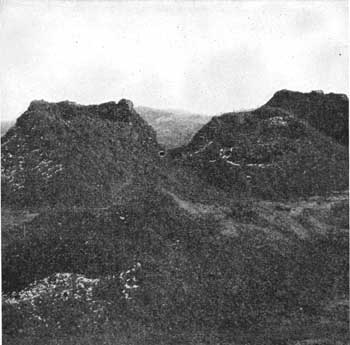![]()
MENU
|
Glimpses of Our National Monuments CRATERS OF THE MOON NATIONAL MONUMENT |

Cinder Cones in Craters of the Moon National Monument.
In the semiarid portion of the Snake River Plateau in south central Idaho, at the foot of the White Knob Mountains, lies the Craters of the Moon National Monument, which was created May 2, 1924, with an area of approximately 39 square miles. The area was in creased by proclamation dated July 23, 1928, to 80 square miles. It is a volcanic region, the most recent example of fissure eruption in the United States, and as its name signifies closely resembles the surface of the moon as seen through a telescope. Nowhere else in the United States can so many volcanic features be found in such a small area.
Although in a mountainous country, the monument itself is a vast plain sloping southward from an elevation of about 5,000 feet at the entrance to about 4,000 feet at the south end. The first volcanic features to be noticed as one enters the monument are numerous smooth cinder cones, while beyond is a huge black stream of lava spread out on the plain for miles. From a distance this appears smooth, but upon closer inspection is found to be exceedingly rough and covered with jagged fragments of lava and cinders. Farther south is a profusion of cinder cones, craters, and hornitos. The cones vary in height from 20 feet to 600 feet. On the western border the black lava flooded up against the southern spur of the White Knob Mountains making bays of lava in each valley, with the mountain ridges projecting between the lava bays like peninsulas extending out into a black sea. It is believed by scientists that the volcanic eruptions.in this area lasted spasmodically over a period of at least a thousand years, and that the final eruptions may have occurred only a few hundred years ago. The newer lava in the northern part of the monument is devoid of vegetation with the exception of a few lichens, and on the cinder cones occasional tufts of wild barley and a few limber pines. The older lava in the southern part supports a sparse growth of grass, brush, and stunted pines, and in the spring some delicately tinted wild flowers.
The lava tunnels and caves are perhaps the most interesting features to visitors. The tunnels, some of which are 30 feet in diameter and several hundred feet long, were formed by lava flowing out from under an already hardened crust which was strong enough to remain standing. In them are beautiful blue and red lava stalactites and stalagmites, and other unusual formations.
Although the area is semiarid and the entire rainfall either sinks at once into the ground or evaporates, water is easily available to the visitor in several interesting ways. The springs that exist in some of the volcanic pits furnish one unusual source of water supply. In one of these springs the water has been found to have a temperature of 34° F. while the air temperature was 87°. Water is also found in the lava tunnels, where it has percolated downward through the lava cracks. In these tunnels the water collects in pools, and in some places ice is found. Near the Bottomless Pit there is a natural ice well. Here, 30 feet inside the throat of an extinct crater, is a pile of snow about 8 feet high, which owing to its protected location remains unmelted throughout the year. This is not recommended as a source of water supply, however, as the ice over the well is thin at times and the well itself is very deep.
The nearest railroad point to the Craters of the Moon National Monument is Arco, which is reached by a 59-mile ride from Blackfoot over the Oregon Short Line Railroad or by a 63-mile motor trip. Comfortable accommodations are available at Arco. From here 23 miles of good road lead to the monument entrance, which is located on the Idaho Central Highway. As this highway connects Boise and all western points with Yellowstone National Park, motorists visiting the Yellowstone can easily take in the Craters of the Moon at the same time.
A free public camp ground has been provided within the monument. There is also a store, with filling station, and cabins may be rented by visitors who do not care to camp out.
R. B. Moore, of Arco, is custodian of the monument.
|
|
Last Modified: Thurs, Oct 19 2000 10:00:00 pm PDT
glimpses2/glimpses7.htm

 Top
Top